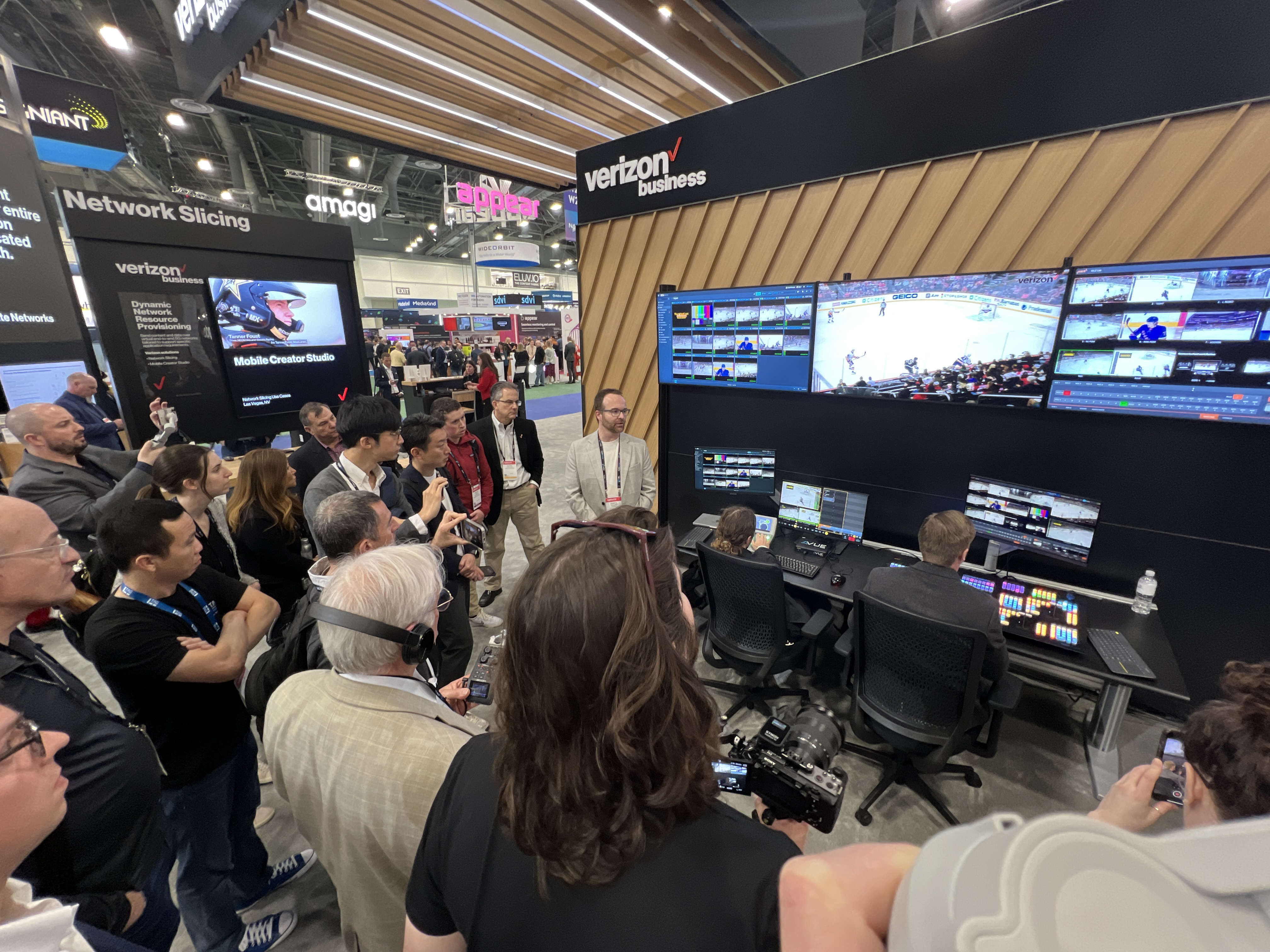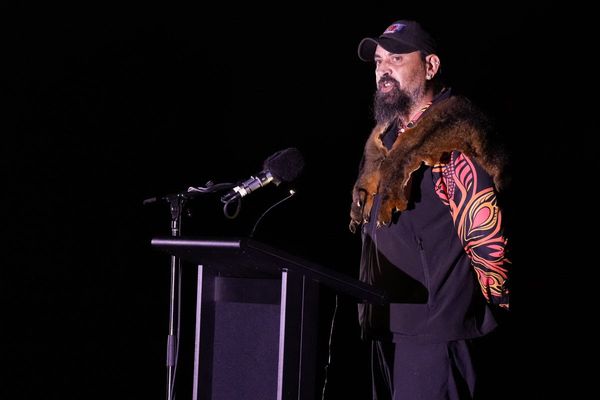
The broadcast industry’s accelerating transition to cloud-based production of sports, news and other live programming is proving far more disruptive to the evolution of video services than seemed likely not so long ago.
The impact came into dramatic focus at the NAB Show, where the paradigm shift was revealed as the inevitable result of industry-wide adoption of SMPTE 2110 in support of the SDI-IP transition. “The whole explosion around cloud production wouldn’t have happened without 2110,” noted Steve Reynolds, president of Imagine Communications.

Widespread adoption has driven costs down to where “2110 has become cheaper than SDI on a per port basis,” leading to experiences with on-premises IP-based news, sports and other live productions that have made workflows “a lot better,” he said. As a result, producers are now comfortable with exploiting the cost savings and collaborative flexibility that comes with moving production to the cloud.
Remote Production
NAB Show exhibit halls teamed with cloud production-related solutions aimed at enabling a streamlined, cost-saving approach to launching linear TV channels combining any mix of live and file-based content for any distribution model, whether it be free-to-air broadcast, pay TV, SVOD, AVOD, or FAST. Now, as Reynolds put it, “FAST is just TV.”
The whole explosion around cloud production wouldn’t have happened without 2110.”
Steve Reynolds, Imagine
An unavoidable testament to the significance of the cloud-to-live broadcast production was the expanded show floor presence of AWS. The superscalar has been benefiting from broadcast industry demand for cloud support for many years, including in the live production arena, but the pace and scale of developments now are unprecedented, said Chris Blandy, director of strategic business development for M&E, games, and sports at AWS.
“There are now more than 4,000 linear channels originated over AWS around the world,” Blandy noted. Much of this activity revolves around collaborations in linear channel development involving combinations of live and file-based content. These AWS customers’ workflows “are bringing in editors, graphic artists, colorists wherever they happen to be while relying on us to maintain tight security in their operating environments,” he said.
AWS demonstrated live news production from the show floor as a way to call attention to what’s happening in the rapidly evolving broadcast news arena. “We’ve seen a lot of innovation in this space, and now we’re seeing it mature into stable production workflows,” Blandy said.
Indeed, as Imagine’s Reynolds noted, cloud production is a big boon to TV stations looking to leverage their unique opportunities to build audiences by streaming local news and other live content. “Station owners can take advantage of remote production using their subchannels to deliver local live content,” Reynolds said. “It gives them new capabilities to differentiate their programming.”
Hybrid Transition for Sports
In the sports world, the shift to cloud production has been slower than in other M&E segments, but now producers are increasingly implementing hybrid transitions that are pushing ever more processes to the cloud while retaining a significant on-prem production presence, noted Deon LeCointe, director of networked solutions at Sony Electronics. With a focus on SE’s Networked Live product portfolio, LeConte has a bird’s eye view of how the company’s preparations for this phase in live sports production is paying off.

SE’s Networked Live solutions come into play with transitions to cloud production anchored by the Nevion VideoIPath media orchestration platform, which Sony acquired in 2020 and has since enhanced to work with SE’s broadcast control solutions. The result, LeCointe said, is a highly scalable, ultra low-latency platform that uniquely combines broadcast operations, orchestration, and monitoring capabilities in hybrid workflows across SDI and IP LAN, WAN. cloud, and 5G networks.
At the NAB Show, SE demonstrated seamless hybrid production through a control panel managing the firm’s software-based M2L-X switcher for cloud operations and the modular MLS-X1 switching appliance for premises-based operations. “We think this is the best approach for sports operations that are pushing the envelope toward the cloud,” LeCointe said.
The National Hockey League made news at the NAB Show as the first big pro league to take the plunge into full cloud production mode. This is enabling the league to deliver personalized experiences to connected devices in and beyond game arenas along with traditional TV broadcasts while substantially reducing costs, said Grant Nodine, senior vice president of technology for the NHL. “With the ability to spin up and rent resources as needed, it doesn’t make a lot of sense to be putting big production trucks in venue,” Nodine said.
The transformation in user experiences across all locations is enabled by a partnership with Verizon as provider of 5G connectivity to in-venue audiences and between the game arenas and the AWS cloud, where productions for in-venue audiences are returned for viewing in sync with live action and productions for external distribution are sent out over the usual channels. “We’re using the cloud as the router of the future,” Nodine said.
FAST Goes Live
The implications of cloud production as the center of gravity for streamlining the supply of linear content across all business models and distribution outlets were top of mind across the playout ecosystem in Las Vegas. “FAST and broadcast used to be separate,” said Dan Marshall, executive vice president for worldwide sales at Amagi. “Now we’re seeing the integration of live content into FAST channels.”
Amagi, like many suppliers, is reconstituting itself to take advantage of the transformation. Traditionally positioned as a provider of playout services, Amagi for some time has been responding to the FAST phenomenon by helping customers with insertions of ads, graphics, QR codes and other elements in live production, according to Marshall. Now the company has gone all the way into support for live production with acquisition of the Polish cloud production supplier Tellyo.
Amagi, in response to the emergence of high-value live programming in the FAST channel mix, has teamed with digital rights management platform supplier Intertrust to enable implementation of license-mandated security in its playout workflows.
With the success of FAST, which now accounts for 25% of TV ad views in the U.S., according to Comcast’s Freewheel unit, Marshall and others said it’s just a matter of time before major sports become part of the FAST lineup, and, sure enough, just before press time, Roku announced that, in a new deal with Major League Baseball, it was becoming the first FAST channel producer to be carrying games from a major pro sports league.
Disrupting Norms
The move of live production to the cloud has realigned the interplay between production and playout in new workflow configurations that rely on ultralow latency connectivity for synchronized execution of tasks wherever they occur. The disruption to past norms is pushing some vendors in new directions and playing right into where others have been from the start.
As a leading player in the latter category, LTN benefitted at the NAB Show from its ability to tout a multi-pronged set of turnkey FAST, addressable advertising, production, and playout solutions, all of which are closely linked to the global B2B LTN Network serving as a multicast playout alternative to satellite distribution.
“We’ve been hearing about the shift to IP and cloud production for well over a decade, and even two years ago we were saying it’s no longer a matter of if, but when,” said LTN CTO Brad Wall. “Now it’s here with a focus on what tools and workflows are out there ready to use with low latency and high reliability.”
The company offers LTN ARC as a fully managed production/versioning system, which Wall said sports producers are leveraging to “manage and customize premier sports at global scale.” He cited a tier one producer delivering soccer games in multiple versions matched to licensing and language requirements as an example of how sports producers are overcoming the market-specific production limitations of the past.
Whether they use ARC or the self-managed LTN Lift playout technology, producers can leverage the new IP production paradigm whether on premises or in the cloud to “empower these types of workflows with all kinds of new branding and marketing opportunities,” he said.
Another company capitalizing on a solution set built from the ground up for this moment is Mediagenix, which offers a software-as-a-service (SaaS) platform enabling broadcast networks and streamers to manage monetization and scheduling of live and stored content across broadcast and OTT footprints. “True transformation is finally happening,” said Mediagenix Chief Product and Marketing Officer Ivan Verbesselt.
“FAST is an example of the business growing up,” he added. “We shouldn’t be building platforms to accommodate business models. We should build business models first using platforms that enable business agility.”
Toward that end Mediagenix has developed tools that allow media companies to manage the complete content life cycle with seamless organization-wide collaboration, Verbesselt said. Platform intelligence, often with AI assistance, enables highly efficient approaches to formulating and budgeting value management strategies, leveraging audience data in the use of metadata, orchestrating dubbing, subtitling, and graphics, scheduling placement in FAST and other channels based on AI predictive ratings, and much else, he explained.
One of the more arresting innovations supporting cloud production comes from Matrox Video, a company best known as a leading decades-old supplier of line cards, encoders, extenders, switches, and other production hardware to OEMs. But in Las Vegas, its focus was on tools that add efficiencies to SDI-to-IP points of conversion and that support connectivity enabling synchronized collaboration across cloud production workflows.

Matrox describes its ORIGIN ultralow latency framework as a “groundbreaking approach” to linking workstations. According to Francesco Scartozzi, vice president of sales and business development for the Matrox Broadcast and Media Group, ORIGIN tailors high-end IT operations to broadcast TV requirements so that each set of tasks in the production process is executed with frame-accurate synchronization across all relevant points of collaboration on the workflow, whether hardware related to the task at hand is positioned on premises on in the cloud.
“ORIGIN is built on a media-aware content transfer fabric,” Scartozzi explained. It treats production applications as completely independent stateless media services sharing a common storage infrastructure with reliance on a mode of low-latency transport that he described without elaboration as “our secret sauce.”
By all appearances, there’s nothing left standing in the way of the transition to live programming production in the cloud other than the remaining life spans of premises-based equipment.
And once those who haven’t yet moved to the cloud start feeling the impact of service innovations introduced by those who have, it wouldn’t be surprising to see a good bit of cost/benefit analysis justifying reductions in those life spans.







